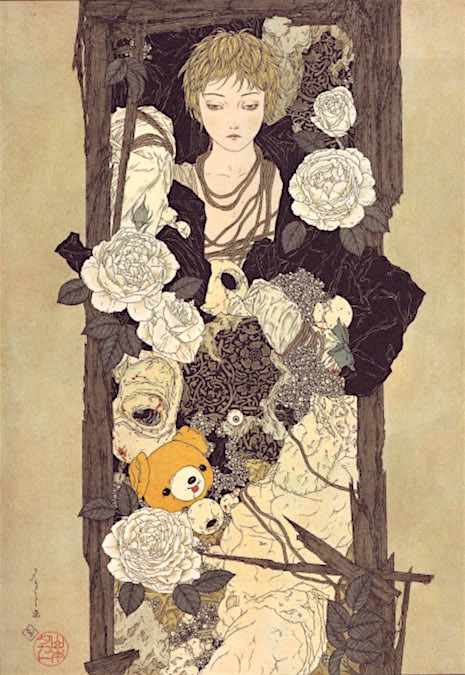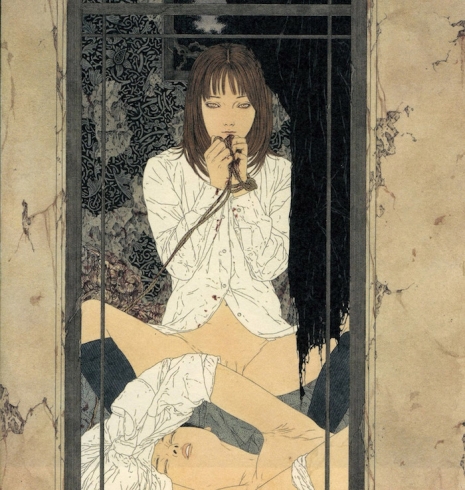
Some artists keep their lives hidden so the focus remains solely on their work.
Takato Yamamoto appears to be such an artist.
Outside of Japan, there is little known about Takato Yamamoto other than he is a Japanese artist who produces beautiful, dark, exquisite paintings of sex and death. Type his name into any search engine and up will pop the words “beautiful,” “dark,” “exquisite,” “sex,” and” death.”
There is also the standard paragraph biography:
Takato Yamamoto was born in Akita Prefecture (Japan) in 1960. After graduating from the painting department of the Tokyo Zokei University, he experimented with the Ukiyo-e Pop style. He further refined and developed that style to create his “Heisei estheticism” style. His first exhibition was held in Tokyo, in 1998.
Yamamoto tags his work “Heisei estheticism.” But this doesn’t really mean much. It’s just a nominal title for something created during the Heisei period. The Heisei period started on January 8th, 1989, with the death of Emperor Hirohito and the ascension of his son Emperor Akihito. It’s little more than a descriptive time frame like saying Shakespeare’s work is Elizabethan drama. The “estheticism” bit references the Aesthetic Movement, which believed in “art for art’s sake” with an emphasis on “the visual and sensual qualities of art and design over practical, moral or narrative considerations.”
The Heisei period is supposedly about the promotion of peace. Yamamoto’s response to this is not only simply aesthetic but also decadent as in the Decadent art movement of the late 19th-century. The French author and pioneer of the Decadent movement, Charles Baudelaire described “decadence” as a preference for what is beautiful and exotic, a literal surrendering to the fantastical. This could be a description of Yamamoto’s work. A closer look reveals there are also some other influences—some Art Nouveau and more than a hint of the Symbolists.
Let’s start with Yamamoto’s mix of sex and fantastical horror which suggest the Decadent paintings of Félicien Rops. The pig motif recalls Rops’ Pornokratès. While his imagery of death contained within the embrace of love recalls Rops obsession with women as potential destroyers—an obsession born out of his fear of syphilis. Add in some other Decadent themes like vampirism, torture, disembowelment, the old favorite of young girls in bondage, and some delicate homoeroticism featuring some beautiful whey-faced androgynous boys, then we have the full checklist.
Then there is Yamamoto’s intricate and exquisite style which recalls the illustrative work of Art Nouveau artists Aubrey Beardsley and Harry Clarke.
All of these clues reveal a highly cultured and intelligent artist creating his own distinctive and, let’s be frank, deeply personal style through the prism of past artistic movements. It’s post-modernist pick ‘n’ mix. Part graphic novel, part Decadent fantasy, part Heisei esthetic, wholly Tamako Yamamoto.


See more of Yamaoto’s work, after the jump…





